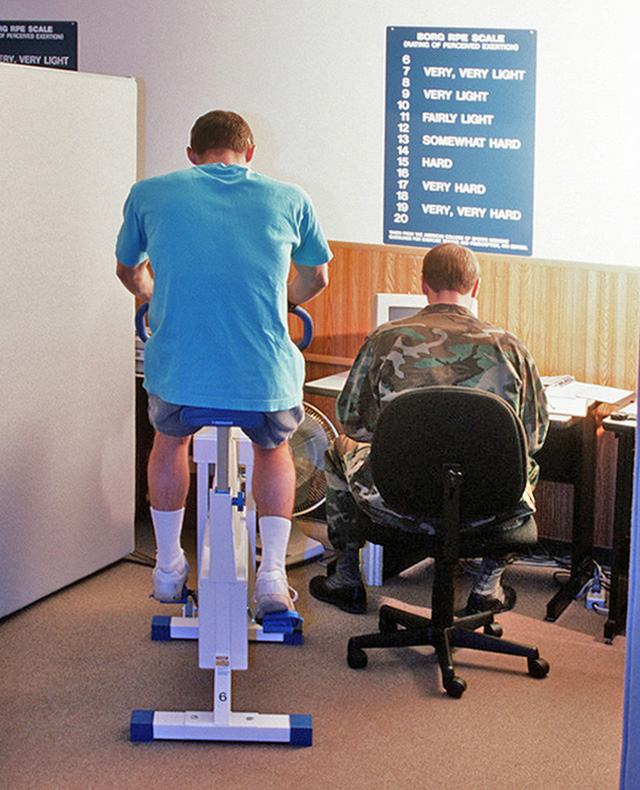The YMCA Sub-Maximal Cycle Ergometer Test is a submaximal cycle ergometer aerobic fitness test. Based on the participant's heart rate response to several submaximal workloads, we can predict what workload, and therefore VO2max, they would have reached if they had continued until their maximum heart rate. There are many other cycling tests and aerobic fitness tests, such as the similar Astrand Cycle ergometer submaximal test.
equipment required: cycle ergometer, clock or stopwatch, heart rate monitor, ECG monitor (optional), metronome (for pedal cadence)
pre-test: Calibrate the cycle ergometer and check all equipment is functional. Explain the test procedures to the subject. Perform screening of health risks and obtain informed consent. Adjust the cycle ergometer seat height and handlebar height. Prepare forms and record basic information such as age, height, body weight, gender, test conditions. Obtain resting heart rate and blood pressure measurements. See more details of pre-test procedures.
description: The subject pedals on the cycle ergometer for 3 minutes at a resistance of 0 kg and a cadence of 50 (this is the warm-up). The subject then pedals for 3 minutes at 150 kgm/min (0.5 kg, 50 cadence). Record the heart rate at 2 minutes and 3 minutes. If these heart rate values are not within 5 bpm, continue for another minute and record the heart rate at 4 minutes. Based on the steady-state heart rate (HR) reached, increase the workload for the second stage based on the details listed in the table below. (note: 6 kgm/min = 1 Watt)
| HR < 80 | HR 80-89 | HR 90-100 | HR > 100 | |
|---|---|---|---|---|
| 2nd stage | 750 kgm/min (2.5kg) | 600 kgm/min (2.0kg) | 450 kgm/min (1.5kg) | 300 kgm/min (1.0kg) |
| 3rd stage | 900 kgm/min (3.0kg) | 750 kgm/min (2.5kg) | 600 kgm/min (2.0kg) | 450 kgm/min (1.5kg) |
| 4th stage | 1050 kgm/min (3.5kg) | 900 kgm/min (3.0kg) | 750 kgm/min (2.5kg) | 600 kgm/min (2.0kg) |
For workloads beyond 4th stage, increase the intensity by 25 watts (0.5 Kp) until termination heart rate is reached (85% of age predicted max). Cool down after the last stage has been completed.
scoring: The aim is to achieve two consecutive workloads where the HR is between 110 bpm and 85% of the age‐predicted HRmax (220-age). One method of calculating the result is to plot the data on a graph, showing the workload on the x-axis and the heart rate on the y-axis. Plot the two last heart rates and extrapolate the line to the predicted maximum heart rate (220-age) and drop a line down from this point to read the predicted maximum workload from the x-axis. There are also formula that can be used to calculate the results.
 Monark cycling test
Monark cycling testadvantages: this is a simple test to administer, reasonably accurate and appropriate for ECG monitoring during exercise.
disadvantages: the test score can be influenced by the variability in maximum heart rate in individuals. It would underestimate the fitness of those with a high maximum heart rate, and overestimate fitness with advancing age (as max HR reduces with age). As it is performed on a cycle ergometer, this test would favor cyclists.
references:
- Beekley MD, et. al. (2004). Cross-validation of the YMCA submaximal cycle ergometer test to predict VO2max. Research Quarterly for Exercise and Sport, AAHPERD; 75 (3), 337-342
Similar Tests
- Astrand Cycle ergometer submaximal test
- YMCA 3-minute Step Test
- PWC170 Test — a submaximal aerobic fitness test on a cycle ergometer
- Tri-Level Aerobic Test
Related Pages
- Fitness tests for cyclists
- Cycling Fitness Tests, assessments involving cycling exercise.
- Cycle Ergometers
- Other aerobic fitness tests
- Are the participants physically prepared for testing?
- More information on measuring heart rate


 Current Events
Current Events